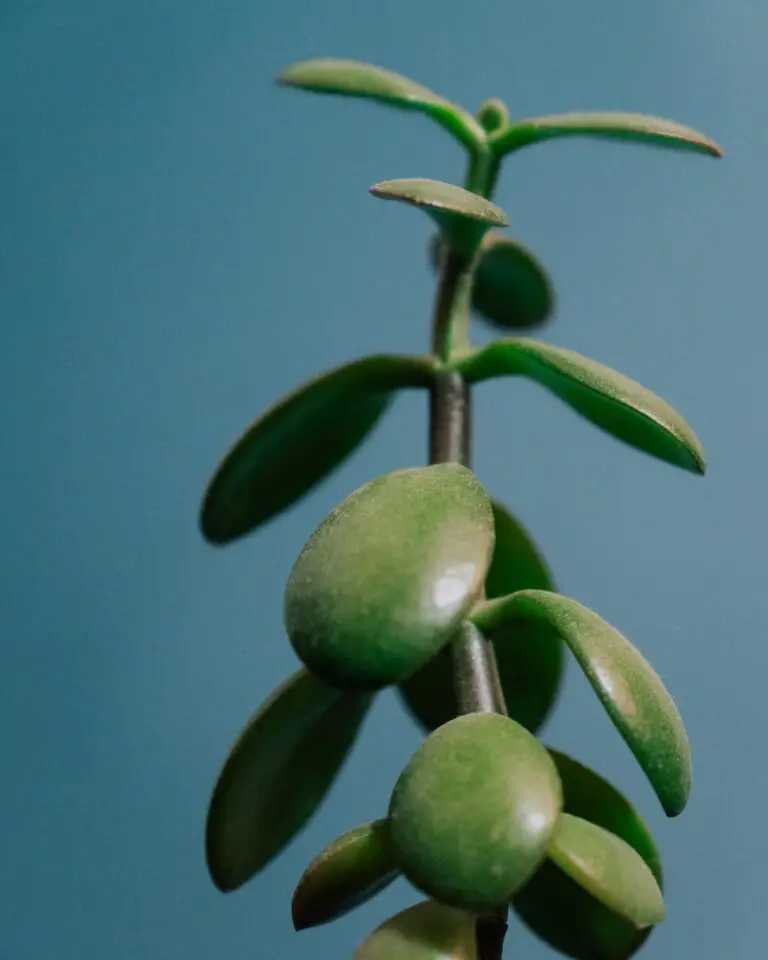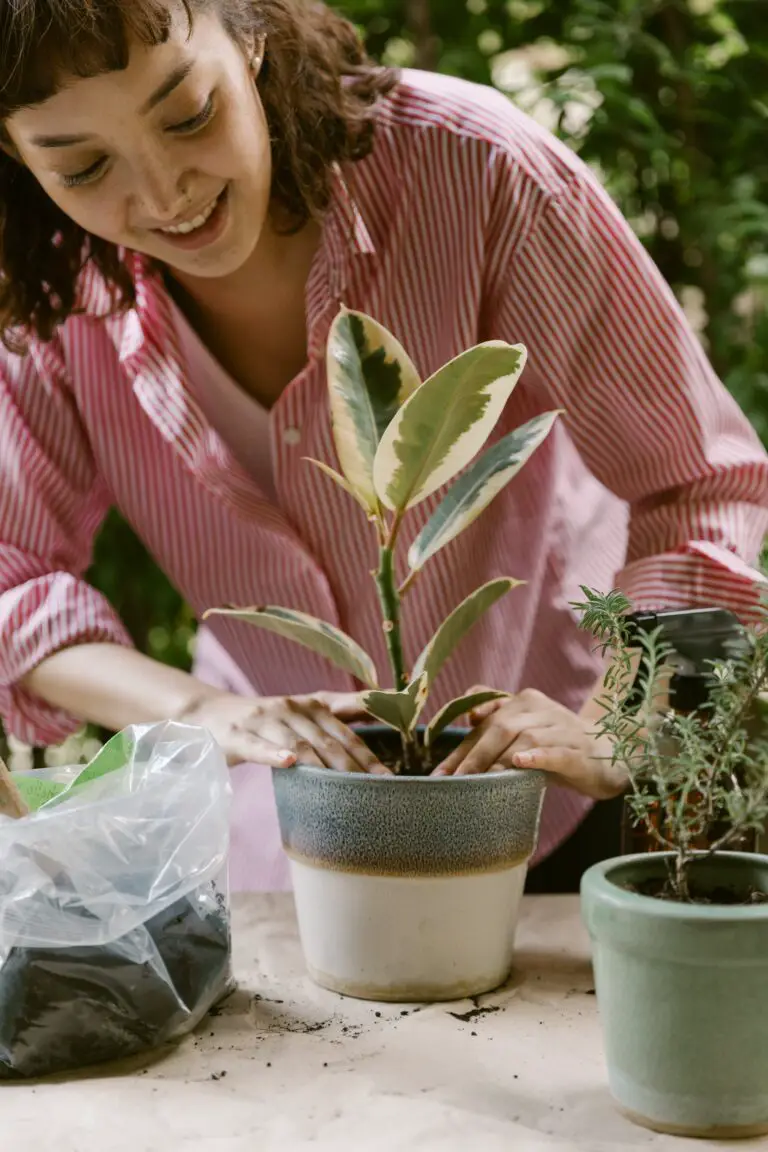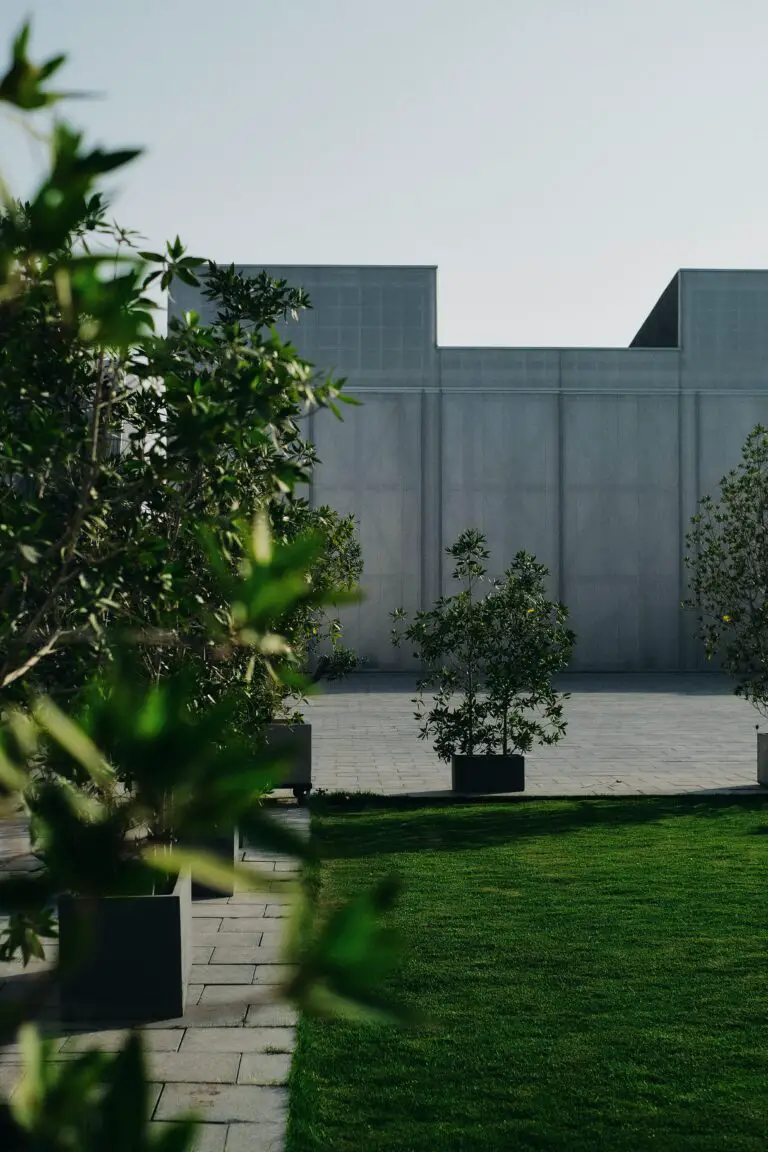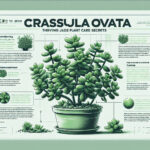Introduction to Crassula Ovata
Imagine a plump, glossy green plant that embodies resilience and charm – that’s Crassula Ovata, endearingly known as the Jade Plant. This succulent, with its jade-colored leaves that sometimes tip reddish in full sun, is rooted deeply not just in soil but also in the world of indoor gardening. It’s a familiar face in offices, windowsills, and living rooms, and for a good reason. The Jade Plant, resembling a mini tree, is often associated with good fortune and has become a staple for plant enthusiasts.
As a native of South Africa, this sturdy little character has journeyed far from its arid origins to grace our homes with evergreen elegance. In a dance of simplicity and sophistication, it has waltzed its way into the category of ‘nearly indestructible houseplants.’ Why? Because they’re champions at adapting to indoor life, requiring minimal attention while offering maximum greenery. It’s not just a plant; it’s a symbol of hardy nature and easy-going vibes.
While Crassula Ovata has gained celebrity status in the realm of indoor décor, the whispering question remains: “can crassula ovata live outside?” Spoiler alert: with the right conditions, many gardeners have witnessed the impressive transformation of their indoor Jade into a robust, open-air wonder.
Is there a secret potion or a spell to this versatility? Not quite! It’s all about understanding the care tips that unchain the Shackled Stonecrop, freeing it to bask in the generous lap of nature.
So, as we ponder the prospect of ushering our beloved Jades out under the open sky, here’s a snapshot of its story. Crassula Ovata: an everyman’s plant that’s more than just an ornamental trinket – it’s a plucky survivor teaching us the art of thriving with grace.

Understanding the Natural Habitat of Crassula Ovata
Ever wondered where the Jade Plant, also known as Crassula Ovata, originated from? It’s like asking a fish about the water it swims in – both are in their element in the perfect environment! Let’s dive into the natural setting where these succulents feel right at home.
Crassula Ovata hasn’t always been a trendy interior decor item. It hails from the rugged landscapes of South Africa, where it stands its ground amidst rocky outcrops and arid ground. This succulent is no stranger to harsh sunlight, sandy soils, and the occasional rain shower. It’s all about the balance between plenty of sun and a good drainage system – think of it as the plant’s favorite cocktail.
Try to imagine a Crassula Ovata basking under the African sky. It’s like watching an athlete in training; the intense sunlight it endures is its daily workout, resulting in those thick, fleshy leaves that store water for the dry spells. It’s a master of self-care, really, ensuring it has reserves to draw upon when times get tough.
Thanks to their South African roots, these succulents are not only tough but also adaptable. They have this incredible ability to thrive with minimal fuss, making them an ideal outdoor companion for gardeners with a busy schedule or those of us who are, let’s say, horticulturally challenged. If you’re hoping to have a Crassula Ovata enjoy the great outdoors, mimic its natural habitat – plenty of sunlight, well-draining soil, and a spot where it can strut its stuff without getting drenched in the rain.
One common sight in the natural habitat of Crassula Ovata is the clear division between growth periods. During the warmer seasons, it goes into overdrive, absorbing the sunlight like it’s going out of style. But when winter knocks on the door, it hunkers down and takes it easy, slowing its growth and savoring its reserves. It’s the ultimate seasonal strategist.
While these plants are synonymous with dry conditions, they do still need a refreshing drink now and then. Picture the sudden rain showers that grace the South African landscape, providing a brief but intense watering session. It’s these organic nuances that you’ll want to replicate to make your Crassula Ovata flourish outside.

So, can Crassula Ovata live outside? Absolutely, but it’s all about recreating that ‘home sweet home’ vibe. Think sunny spots, occasional showers, and well-draining soils. With these tips in mind, watch your Crassula Ovata stand tall and proud, just as it would in the wilds of its ancestral plains.
Climate Considerations for Outdoor Crassula Ovata
When it comes to inviting the resplendent Crassula Ovata into your garden, there’s a symphony of climatic cues you’ll want to pay attention to. To understand how to coax the best out of these succulent serenaders and whether they can don their green gowns in your outdoor spaces, let’s dive into the meteorological melodies they dance to.

For starters, think of Crassula Ovata as your garden’s sun-seeking compass. Originally hailing from the sun-drenched landscapes of South Africa, these leafy treasures revel in the joy of day-long sunshine and prefer climes where the sun plays peekaboo only occasionally. While they have a penchant for basking in bright light, they’re not fans of scorching summer afternoons. A locale that provides dappled sunlight, sheltered from the harshest rays, makes for a harmonious habitat.
Avoiding frosty farewells is crucial, as Crassula Ovata’s succulence is no match for the icy grip of frost. Mild winters and temperate zones allow these jade gems to flourish outside. If Jack Frost does come knocking, consider a strategy to keep your succulents snug. Regions that consistently hover above 30°F (-1°C) can become a sanctuary for these plump-leafed beauts without necessitating a seasonal indoor retreat.
Rainfall, that unpredictable orchestra conductor, plays a big part too. Crassula Ovata prefers a scheduled symphony of watering rather than a freeform jazz approach. Areas with an annual performance of light to moderate rainfall strike the right chord, simulating the natural periods of drought and deluge the plant is accustomed to.
For those eager to forge a green bond with Crassula Ovata, the key is to tune into the rhythms of your regional clime and see if it harmonizes with these solar-powered performers. Check out our detailed guide on the best practices for growing Crassula Ovata, and you could be choreographing your own succulent symphony in no time!
Engaging with these climate considerations will strike the right note in allowing your outdoor Crassula Ovata to not just survive, but to hold an open-air concert in your garden all year round.
The Transition: Moving Crassula Ovata Outdoors

Are you pondering the possibility of letting your cherished Crassula Ovata breathe in the open air? Good news! It’s not just a wild idea; it can actually invigorate your succulent, giving it a touch of Mother Nature’s genuine embrace. But before you usher your green companion outside, let’s map out the journey to ensure a seamless transition to its new sunny abode.
First things first, acclimatization is the name of the game. Think of it as a ‘get to know you’ phase between your Crassula Ovata and the great outdoors. Start by choosing a sheltered spot where the plant can soak up the morning sun while being protected from the harsher afternoon rays. It’s a gradual meet-and-greet, avoiding sunburn and shock, which can make even the toughest succulents wave a white flag.
Timing is crucial, much like finding the perfect moment to savor an espresso on a patio. Spring or early summer provides an ideal window for this venture, as milder temperatures and longer days set a welcoming stage. This period allows your Crassula Ovata to acclimate to temperature fluctuations under the protective eye of a gentle weather pattern.
For an engaging real-life example, consider Emily’s journey with her Crassula Ovata. Emily, who religiously followed the mantra ‘start slow and stay steady,’ moved her plant from her bookshelf, which was a sun-filtered sanctuary, to a cozy corner on her balcony. Over two weeks, she gradually increased its outdoor stay, and today, her Crassula Ovata stands proudly under open skies, plump leaves glistening with dew.
As you prepare for this transition, remember it’s a dialogue between plant and environment. Regular checks for leaf discoloration or soft spots will offer insights into how well your Crassula Ovata is adapting. And if you’re looking for more pointers on addressing the charming but sometimes puzzling world of succulents, have a peek at this resourceful guide on Crassula Jade Care. It’s your green thumb’s best friend!
Seasonal Care for Outdoor Crassula Ovata
For those of us with a green thumb, Crassula Ovata, or the Jade plant, is more than just a succulent—it’s a resilient companion that adds a lush, vibrant touch to our outdoor spaces. But as the seasons turn, from the sweltering summer to the frosty winter, how do we ensure our green friend not only survives but thrives in the great outdoors? Let’s dive into a year-round care guide that will turn you into a Crassula Ovata champion!
Spring: A Fresh Start for Growth
When spring showers begin to fall, your Crassula Ovata is waking up from its winter slumber, ready to stretch its leaves towards the sun. This is the time for moderate watering as consistent moisture will encourage new growth. Shielding the plant from direct midday sunlight can prevent scorching, so consider a spot that enjoys morning light and afternoon shade. It’s akin to sipping a gentle morning coffee rather than a midday espresso shot—gentle on the system and perfect for a steady start.
Summer: Basking in the Glory
As the warmth intensifies, so does your Crassula Ovata’s thirst. Regular watering during dry spells is key—think of it as your plant’s very own cooling mist on a hot beach day. However, be mindful of not overdoing it; the well-draining soil will help avoid waterlogged roots. Imagine the succulent’s plump leaves as tiny reservoirs, storing water and basking in the glory of summer’s embrace.

Fall: Preparing for the Chill
As the autumn leaves begin to swirl, it’s a signal to scale back the watering regime of your Crassula Ovata. Just like animals preparing for hibernation, your Jade plant is getting ready to conserve its resources for the winter. Now’s the time to bring it to a sheltered location if your region experiences a hard freeze. Think of it as tucking in your plant with a warm blanket, cozy and protected from the upcoming chill.
Winter: A Cool Rest
Winter is a rest period for Crassula Ovata. Watering should be minimal—only when the soil is dry to the touch. A cool but not icy environment is ideal. If you’ve seen frost effortlessly settle on a windowpane, that’s the level of cold your Jade plant should experience—frost that’s present but not penetrating. The chilling period is crucial, though, as it sets up your plant for a cycle of robust growth when spring comes around again.
Interested in more intricate details about caring for your beloved Jade plant outdoors? Check out this comprehensive guide that’ll walk you through everything you need to know to keep your Crassula Ovata in tip-top shape.
With the right balance of watering, sunlight, and temperature control, Crassula Ovata can be more than just a houseplant—it can become an indelible part of your outdoor sanctuary. Watch it flourish through the seasons, and feel a sense of pride as you master the art of its care.
Common Challenges and Solutions for Outdoor Crassula
Welcoming Crassula Ovata, or as many know it, the Jade Plant, into your outdoor garden invites a set of challenges unique to this succulent. Like a character in an adventure novel, your Crassula will face its own set of trials and tribulations when living outside the cozy confines of the home. Let’s embark on a horticultural journey to understand these adversities and chart a course toward thriving outdoor growth.
The common garden villains – pests and diseases – often prey on Crassula left in their natural habitat. Mealybugs, with their cotton-candy disguise, sneak up to suck the life from your unsuspecting plant. But fear not! A simple concoction of soap and water sprayed with vigilance can vanquish these pests. As for diseases, overwatering invites unwelcome fungal guests. Strike a balance with watering, mimicking the plant’s native desert rain schedule, to keep rot at bay.

Weather extremes pose another thrilling challenge. Too much sun and Crassula Ovata might wilt like a castaway without shade. Too little, and it might as well hibernate. Yet, the jade plant’s resilience shines. It hoards moisture in its leaves to outlast drought, and a strategic placement with partial shade can help it weather the scorching midday sun. In colder climates, a frost blanket might become its best companion, guarding against the icy touch of frost.
Let’s not forget about the scenario every outdoor gardener fears: the perfect storm. Yes, a combination of downpours, freezing temperatures, and gusting winds can make you think your Crassula is on an expedition to the North Pole rather than basking in your backyard. In such cases, having a portable shelter ready to deploy or choosing a strategically sheltered locale is akin to giving your Crassula Ovata its own superpower against the elements.
Embracing these challenges with the right solutions turns your garden into a sanctuary for Crassula Ovata. Watching your succulent survive and thrive outdoors isn’t just gratifying; it’s a testament to the resilience of nature and the creativity of a dedicated gardener. So, as you adjust your shield and sharpen your sword, remember that each solution equips your green ally for the great outdoors adventure.
Success Stories: Crassula Ovata in Gardens Around the World
In the verdant corners of urban backyards and sprawling rural landscapes, the adaptable Crassula ovata, or Jade Plant, stands as a testament to nature’s resilience. These remarkable succulents have not only survived but flourished outside of their native habitat, and their success stories are as diverse as the climates they’ve conquered.
Consider the tranquil patios of Southern California, where Crassula ovata basks in sun-drenched glory. Home gardeners here often boast specimens that have become centerpieces of their outdoor living spaces. Their thick, glossy leaves shimmer under the golden sunlight, and the plants grow with a vigor that makes them local conversation pieces.

Moving across continents, in the bustling heart of Tokyo, these resilient plants have been spotted thriving amidst high-rise apartments and concrete jungles. Balcony gardeners in Japan treat Crassula ovata as a symbol of prosperity, tucking them into corners where they serve as green beacons of peace and natural beauty against the steel backdrop.
Even in more temperate zones with cooler climates, such as the United Kingdom, Crassula ovata has been acclimatized to outdoor conditions. Sheltered within microclimates created by garden walls or grown in containers that can be moved to protect them from extreme cold, these hardy specimens demonstrate the plant’s adaptability to varying environments.
What’s even more astonishing is the sight of Crassula ovata in full bloom in the Mediterranean regions. Here, the bright sunlight coaxes out clusters of starry white or pink flowers, a relatively rare sight that becomes a celebration of life’s simple pleasures for many garden enthusiasts.
Through careful cultivation, protection from harsh conditions, and a touch of gardeners’ love, Crassula ovata continues to adorn outdoor spaces across the globe, weaving a green tapestry of success stories that inspire and showcase the plant’s tenacity and grace.
Frequently Asked Questions
As a gardener, figuring out how to keep your plants thriving can turn your garden into an outdoor sanctuary. Especially when it comes to Crassula Ovata—also known as the Jade Plant—an evergreen with a reputation for being impressively resilient. Whether you’re nurturing your Jade in the confines of cozy pots or letting them spread their roots in the garden soil, you’re bound to have a few questions about their outdoor adventures. So let’s dig into some of the most commonly asked questions about keeping Crassula Ovata outdoors!
Can Crassula Ovata survive winter outdoors?
Surviving through winter might seem like a tough gig for a Crassula Ovata, especially with its succulent leaves that seem to scream “Keep me warm!”. However, with proper preparation, these sturdy plants can withstand chillier seasons. Remember our friend Dan, from the chilly suburbs? He adds a layer of mulch around his Jade plants and moves pots to a sheltered location to fend off frostbite, ensuring they see the spring.
How often should Crassula Ovata be watered when outside?
Now, this is where Crassula Ovata shows its low-maintenance charm! These succulents love a good drink, but only occasionally. Assess the moisture of the soil like our pal Sarah does—sticking a finger in about an inch deep. If it’s dry, it’s time to water. Usually, this happens biweekly during growing seasons and less frequently when the plant’s growth slows down.
Do outdoor Crassula Ovata plants need fertilizer?
Think of fertilizer as an occasional spa day for your Crassula Ovata—good for health and vitality, but not a daily necessity. These plants aren’t greedy for nutrients but providing a balanced half-strength succulent fertilizer during the growing season, as our neighborhood plant enthusiast Bob does, encourages lush growth without overwhelming your Jade.
How to protect Crassula Ovata during a heat wave?
When the sun’s rays beat down relentlessly, your outdoor Crassula Ovata could use a bit of shade. Just like Lisa, who creates temporary shade with a light cloth when the forecast screams ‘heat wave’. This helps prevent sunburn on those gorgeous green leaves and keeps the soil from drying out too fast.
Can Crassula Ovata grow in pots outside as well as in the garden soil?
Crassula Ovata is versatile! Whether in the snugness of a pot or in the freedom of garden soil, they thrive. Tim, an urban gardener, has a stunning display of potted Jade plants adorning his rooftop terrace. Meanwhile, country gardener Ellen boasts a bed of Crassula intermingled with other drought-tolerant plants. The secret? Good drainage and the right pot size or soil space to let those roots breathe and expand.




